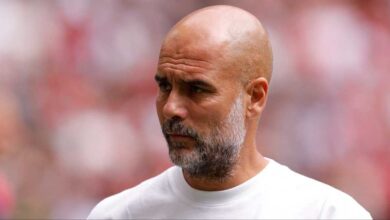Viktor Gyokeres: Arsenal’s New Striker Makes His Mark in Asia

The Emirates faithful who made the journey to Hong Kong for Arsenal’s final pre-season fixture of their Asian tour witnessed a moment that perfectly encapsulated the modern game’s approach to integrating new signings. Viktor Gyokeres, the Swedish striker whose arrival from Sporting CP had dominated headlines throughout the weekend, found himself watching from the sidelines as the North London Derby unfolded before him. It was a measured decision from Mikel Arteta, one that spoke to both the manager’s tactical pragmatism and his understanding of the delicate process required to seamlessly integrate a player of Gyokeres’ caliber into Arsenal’s well-oiled machine.
As the teams emerged from the tunnel for what promised to be a captivating encounter against Tottenham Hotspur, all eyes were on the Arsenal bench. The 26-year-old striker, resplendent in his new red and white training kit, cut a composed figure as he observed his new teammates prepare for battle. For Gyokeres, this moment represented the culmination of months of speculation, weeks of negotiations, and days of anticipation. The Swedish international had finally arrived at the Emirates, and while he may not have been thrust immediately into the starting eleven, his presence alone seemed to energize both the traveling Arsenal support and his new colleagues.
The decision to start Kai Havertz as Arsenal’s number nine for the third consecutive pre-season match was hardly surprising, yet it continued to generate fascinating tactical discussions among supporters and pundits alike. The German international’s transformation from a versatile attacking midfielder at Chelsea to Arsenal’s primary striker has been one of the most intriguing storylines of the current campaign. Against Tottenham, Havertz once again demonstrated the unique qualities that have made him such an effective focal point in Arteta’s system.
Operating in the false nine role, Havertz’s movement created space for Arsenal’s wingers to exploit, while his technical ability allowed him to drop deep and participate in the build-up play that has become synonymous with Arsenal’s possession-based approach. The German’s understanding of when to drift wide, when to make runs in behind, and when to hold up play has evolved significantly under Arteta’s tutelage. His positioning against Spurs was particularly noteworthy, as he consistently found pockets of space between the lines, causing confusion among the Tottenham defenders who were unsure whether to follow him or maintain their defensive shape.
The contrast between Havertz’s style and what Gyokeres is expected to bring to the team was evident even from the touchline. While the German excels in creating space and linking play, the Swedish striker represents a more traditional center-forward option – someone who can provide a consistent goal threat through runs in behind the defense and clinical finishing in the penalty area. This tactical flexibility gives Arteta multiple options depending on the opponent and the specific requirements of each match.
Since his weekend arrival from Sporting CP, Gyokeres had participated in just a handful of training sessions with his new teammates, but those brief glimpses had already provided plenty of encouragement for Arsenal supporters. The striker’s integration into the squad appeared seamless, with reports from the training ground suggesting that his work ethic and professionalism had immediately impressed both the coaching staff and his fellow players.
The thousands of Arsenal fans who gathered in Hong Kong to watch their team prepare were treated to an early preview of what Gyokeres might offer. During the open training session, the Swedish striker demonstrated the clinical finishing that had made him such a coveted target during the summer transfer window. His two goals during the practice drills drew roars of approval from the traveling supporters, who were clearly eager to see their new signing in action.
These training ground moments, while not carrying the weight of competitive fixtures, often provide valuable insights into a player’s mentality and technical ability. Gyokeres’ composure in front of goal, even in a practice setting, suggested that the pressure of his high-profile move to Arsenal had not affected his natural instincts as a finisher. The way he struck the ball with both feet, the variety of his finishes, and his movement in the penalty area all hinted at the qualities that had convinced Arsenal to invest heavily in his services.
The Swedish striker’s interaction with his new teammates during these sessions was equally encouraging. Football is ultimately a team sport, and the ability to quickly build relationships and understand the movement patterns of fellow attackers is crucial for any new signing. Early reports suggested that Gyokeres had already begun to develop an understanding with players like Bukayo Saka, Gabriel Martinelli, and Martin Ødegaard – connections that would prove vital once the competitive season began in earnest
Following Arsenal’s impressive victory over Newcastle United on Sunday, Mikel Arteta’s post-match press conference provided interesting insights into his thinking regarding squad rotation and the integration of new signings. The Spanish manager, known for his thoughtful approach to team selection and tactical preparation, was characteristically coy when questioned about Gyokeres’ immediate role in the team.
Arteta’s reluctance to make bold proclamations about his new striker’s playing time reflected a manager who understands the complexities of modern football squad management. With Arsenal competing on multiple fronts in the upcoming season – Premier League, Champions League, FA Cup, and Carabao Cup – the ability to rotate players and maintain squad harmony will be crucial to their success.
The decision to ease Gyokeres into the team gradually rather than throwing him directly into the starting eleven demonstrated Arteta’s long-term thinking. The manager has consistently emphasized the importance of players understanding his tactical system before being given significant responsibilities. This approach has served Arsenal well in recent seasons, with players like Declan Rice and Kai Havertz himself requiring time to fully adapt to Arteta’s methods before becoming indispensable members of the squad.
Arteta’s management style extends beyond tactical considerations to encompass the psychological aspects of player development. By not placing immediate pressure on Gyokeres to be the instant solution to Arsenal’s attacking needs, the manager was creating an environment where the striker could develop confidence and understanding at his own pace. This measured approach often leads to better long-term outcomes, as players feel supported rather than pressured during their adaptation period.
Gyokeres’ journey to Arsenal via Sporting CP represented one of the most fascinating transfer stories of the summer window. The Swedish striker’s time in Lisbon had been nothing short of remarkable, with his goal-scoring exploits in both domestic and European competitions catching the attention of clubs across Europe’s elite leagues.
At Sporting, Gyokeres had developed into one of Europe’s most clinical finishers, combining raw pace with intelligent movement and a striker’s instinct for finding the back of the net. His success in Portuguese football, while impressive, raised questions about how his skills would translate to the intensity and physicality of the Premier League. The English top flight has proven to be a challenging environment for many talented strikers, with the pace of the game and defensive organization often requiring significant tactical adjustments.
However, Gyokeres’ physical attributes suggested that he was well-equipped to handle the demands of English football. Standing at 6’1″ with a powerful frame, the Swedish international possessed the physical presence to compete with Premier League center-backs while maintaining the pace and agility necessary to exploit space in behind defensive lines. His goal-scoring record at Sporting demonstrated not just his ability to find the net regularly, but his capacity to score different types of goals – tap-ins, long-range efforts, headers, and clinical finishes in one-on-one situations.
The tactical education he received under Sporting’s coaching staff also prepared him well for the sophisticated systems employed by top Premier League clubs. His understanding of when to press, when to hold up play, and how to create space for teammates had been refined during his time in Portugal, making him an ideal fit for Arteta’s possession-based approach.
Arsenal’s pre-season tour of Asia represented more than just preparation for the upcoming season; it was an important part of the club’s global outreach strategy. The presence of thousands of Arsenal supporters in Hong Kong highlighted the international appeal of the Premier League and the passionate following that English clubs enjoy across Asia.
For Gyokeres, this tour provided an ideal introduction to the global nature of modern football stardom. The enthusiastic reception he received from Arsenal fans in Asia demonstrated the immediate impact that high-profile signings can have on a club’s international profile. His goals during the training session were shared across social media platforms, introducing him to Arsenal supporters who might not have been familiar with his previous work at Sporting CP.
The Asian tour also provided valuable preparation time for the coaching staff to work with their new signing in a relatively low-pressure environment. Unlike the intense scrutiny that accompanies Premier League fixtures, pre-season matches allow players and coaches to experiment with different tactical approaches and build understanding gradually.
The cultural exchange aspect of these tours should not be underestimated either. For players like Gyokeres, experiencing different cultures and connecting with diverse fan bases helps broaden their perspective and understanding of football’s global reach. These experiences often translate into stronger connections with international supporters and a greater appreciation for the responsibilities that come with representing a club of Arsenal’s stature.
The addition of Gyokeres to Arsenal’s attacking options provides Mikel Arteta with fascinating tactical possibilities. The Swedish striker’s profile differs significantly from the other attacking players in Arsenal’s squad, offering a more traditional center-forward option compared to the false nine approach that has been successful with players like Havertz and Gabriel Jesus.
Gyokeres’ arrival allows Arsenal to potentially shift between different attacking philosophies depending on the opposition and match situation. Against teams that employ a low defensive block, his ability to make runs in behind the defense and finish clinically in the penalty area could prove invaluable. His physical presence also offers Arsenal a different dimension when dealing with crosses and set-piece situations.
The Swedish striker’s pace and direct running style complement the creativity of players like Martin Ødegaard and the wing play of Bukayo Saka and Gabriel Martinelli. His movement patterns could create space for these players to operate, while his finishing ability provides them with a reliable target for their creative passes and crosses.
From a tactical perspective, Gyokeres’ versatility allows him to operate in multiple formations. Whether Arsenal employs a 4-3-3, 4-2-3-1, or even a 3-5-2 formation, the Swedish striker possesses the technical and physical attributes to adapt to different tactical requirements. His ability to press from the front, hold up play when necessary, and make intelligent runs across the defensive line makes him a valuable asset in Arteta’s tactical arsenal.
As Arsenal’s pre-season tour concluded and attention turned toward the competitive season, the expectations surrounding Gyokeres began to crystallize. The Swedish striker’s reputation as a proven goal-scorer created natural anticipation among supporters, but the reality of adapting to a new league, new teammates, and new tactical system would require patience from all parties involved.
The Premier League’s unforgiving nature means that new signings are often judged harshly if they don’t make an immediate impact. However, Arsenal’s recent history with player development suggests that Gyokeres will be given the time and support necessary to reach his full potential. The club’s patience with players like Kai Havertz, who took time to find his best position and role within the team, provides a template for how they might handle their new striker’s integration.
The upcoming season will test not just Gyokeres’ individual abilities, but also his capacity to contribute to Arsenal’s collective ambitions. The club’s pursuit of Premier League and Champions League success requires contributions from every member of the squad, and the Swedish striker’s role in achieving these objectives will likely evolve throughout the campaign.
As the Asian tour concluded and Arsenal prepared to return to London, Viktor Gyokeres could reflect on a successful introduction to life at his new club. While his bench start against Tottenham might have disappointed some observers, it represented the beginning of what promises to be an exciting journey. The thousands of Arsenal fans in Hong Kong who witnessed his training ground goals had seen a glimpse of the future, and the excitement surrounding his arrival suggested that his time at the Emirates would be closely watched by supporters around the world.
The Swedish striker’s story at Arsenal was just beginning, but the early signs suggested that both player and club had made a wise decision in coming together. As the new season approached, all eyes would be on how quickly and effectively Gyokeres could make his mark in the Premier League, adding his name to the long list of successful strikers who have thrilled Arsenal supporters over the years.














